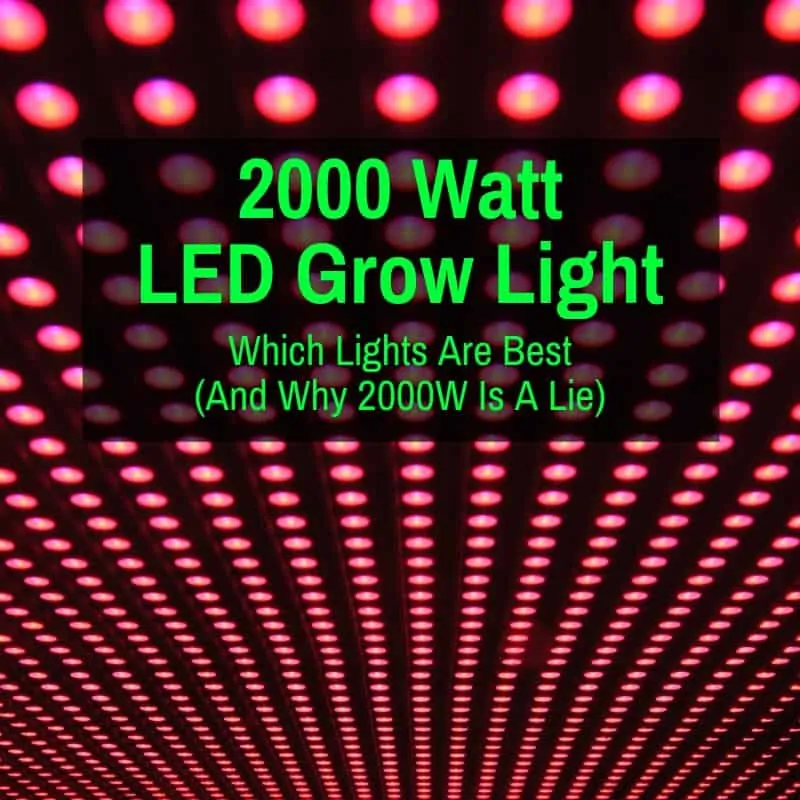
No “2000 Watt” LED grow light actually uses 2000w.
In fact, there is no actual 2000 watt light available on the market.
The biggest brands don’t even advertise anything above 1000 watts.
Many of the larger Chinese brands, however, have “2000 watt” lights. Some go up to “3000 watts.”
But even just a quick look at their specs will show you how much they are exaggerating.
For whatever reason, it has become common practice among Chinese manufacturers to greatly exaggerate their lights’ wattage.
Does this mean the lights are no good?
No. At least not always.
Most of them are pretty useless when it comes to flowering plants, that is true.
But a few actually do get the job done.
And that’s the reason for this article. I wanted to weed out all the low quality lights and help you narrow your decision down to only those lights that are actually effective.
But I also wanted to make sure you know that none of these lights actually use 2000 watts (you wouldn’t even want a light that consumes 2000w….just imagine that power bill!).
None of these lights are equivalent to a 2000 watt HID light either. That’s not where that figure came from.
The manufacturers call their lights “2000w”, because they have two hundred 10 watt diodes. If those diodes were driven at their full capacity, the light would use 2000 watts.
But they aren’t. They are driven at less than 2 watts. That makes the 2000 number greatly exaggerated.
And it’s not just the wattage. Every one of these manufacturers also greatly exaggerate the coverage area of their lights.
Not to worry.
I’ll make sure to let you know how much power each light actually uses and what it is equivalent to, in terms of HID lighting. I’ll also give you a more accurate idea of the coverage area you can expect.
With that information, you will be able to decide on the right light for you.
Contents
- 1 Best 2000 Watt LED Grow Lights: Comparison Table
- 2 Best 2000 Watt LED Grow Light: Reviews
- 2.1 Best Overall: Spider Farmer SF2000 Quantum Board LED Grow Light
- 2.2 Quantum Alternative: Viparspectra XS2000 LED Grow Light
- 2.3 2nd Alternative: Mars Hydro TSW2000 LED Grow Light
- 2.4 Best COB Light: Aglex COB Series 2000W LED Plant Light
- 2.5 Best Blurple Light: BestVA DC Series 2000W Full Spectrum LED Panel
- 2.6 KingLED KP2000 Full Spectrum Light
- 3 2000 Watt LED Grow Light: Final Thoughts
Best 2000 Watt LED Grow Lights: Comparison Table
Best 2000 Watt LED Grow Light: Reviews
The following are our six favorite 2000 watt LED grow lights. We included three full spectrum white light quantum board style of lights, one COB light and two new-style blurple lights. Whichever type you prefer, there is something for you below.
If you’re not sure, the Spider Farmer is our favorite.
Best Overall: Spider Farmer SF2000 Quantum Board LED Grow Light
- Uses 200 watts — save about 50% on your electric bill over HID lights
- Equivalent to a 400 watt HID system — but costs less to buy AND to operate
- Ideal spectrum for plants — 3000K and 5000K white light, plus 660 nm red and 760 nm IR is perfect light for all stages of growth
- Highly efficient — great output from a low power usage (2.7 μmol/J)
- 2.2 grams per watt max yield — yields equivalent to top brand lights, but at a fraction of the price
- 2 by 4 foot core coverage — the coverage for vegging is a bit larger at 3 by 3 feet
- Samsung LM301B diodes — the same diodes used in much more expensive HLG fixtures
- Dimmable Driver — can be removed from the unit and placed outside your grow tent to keep heat down
- Rated for 50,000 hours — 4-5 years with no bulb changes
- 3 year warranty — and a 30 day money back guarantee; they have service centers located in the US, Canada, UK and Germany
Spider Farmer tops our list, because they are the best of the budget LED grow light brands from China. The other brands below are all good too, but I prefer Spider Farmer.
I also prefer the full-spectrum white light this fixture gives you. It contains all wavelengths, just like the sun. Spider Farmer supplements the 3000K and 5000K white light with 660 nm deep red and 760 nm infrared light, for a big boost during flowering.
It covers a core area of 2 by 4 feet for flowering, which is less than the top lights. In terms of output, it gives you 527 umol/s at 18 inches and consumes 202 watts. It is more or less equivalent to about 400 watts of HID power.
Spider Farmer lights use the Samsung LM301B diodes, which are the most efficient on the market. The drive them with their own drivers (formerly they used MeanWell) that are designed specifically for their lights. The result is an incredibly efficient 2.7 μmol/J.
Like all quantum style lights, they dissipate heat efficiently, meaning there is no need for a fan in the fixture. These lights run silent and there are no fans that can break.
Overall, you can expect yields up to 2.2 grams per watt. This is still a Chinese brand, but they do customer service better than most and have a US service center. They also guarantee their lights for 3 years and you can return them for 30 days.
Pros
- Great spectrum for all stages of growth, and especially good for flowering
- Highly efficient 2.7 μmol/J, means each dollar spent on electricity gives you more in return
- Yields up to 2.2 watts per gram
- High quality components
- 3 year warranty and 30 day money back guarantee
Cons
- Coverage area of 2 x 4 feet not ideal for 3×3 or similar tent sizes
- More expensive than the blurple and COB lights below
Quantum Alternative: Viparspectra XS2000 LED Grow Light
- Uses 240 watts — save about 40% on your electric bill over HID lights
- Equivalent to a 400 watt HID system — but costs less to buy AND to operate
- Great full spectrum white light — works for all stages of growth, and especially strong for flowering
- 3 by 3 foot core coverage — perfect for a smaller grow tent
- Dimmable — dim from 100% down to 5% to save on electricity costs when full power is not needed
- Incredibly efficient — 2.7 umol/J makes it one of the most efficient grow lights available
- Samsung LM301B diodes — highly efficient with deeper canopy penetration
- MeanWell HLG driver — industry leading driver with a lifetime warranty
- Includes IR light — promotes flowering and boosts yields
- Runs on AC100 to 240V — will work in any country
- Rated for 100,000 hours — 10 years with no need to change bulbs
- 3-year warranty and 30 day money back guarantee — risk-free purchase
The Viparspectra XS2000 is very similar to the Spider Farmer fixture. It also uses Samsung chips, plus a MeanWell driver. Spider Farmer used to use those, but switched to their own driver specifically designed for their lights.
Overall, we prefer Spider Farmer, but they and the Viparspectra are pretty close. I’d just get whichever light fits better in your setup and/or, whichever one is selling for the lowest price (they all fluctuate a lot).
The XS200 has almost the exact same spectrum too. The difference is that it uses 730 nm IR diodes, instead of 760 nm. I doubt that makes any difference.
In terms of output, they are pretty similar too. Viparspectra claims their light has a larger output, but that is likely exaggerated. Chinese brands tend to do that, with Spider Famer being less guilty than others. Mars and Viparspectra definitely do it more.
The fact that Viparspectra themselves list the same efficiency of 2.7 umol/J as Spider Farmer, while the power consumption is 240 watts, means that the output can’t be that much higher. The SF used 200 watts, so you do expect a bit more output from the Vipar, but not as much of a difference as claimed.
The coverage area is also the same, with a 3 by 3 foot core coverage for flowering (4 by 4 feet for vegging). You also get a 3 year warranty and you can return the light for 30 days.
Pros
- Great spectrum for all stages, especially flowering
- Highly efficient at 2.7 umol/J
- High quality components
Cons
- Somewhat exaggerated PPFD numbers
- Higher cost than blurple or COB lights
2nd Alternative: Mars Hydro TSW2000 LED Grow Light
- Uses 300 watts — save about 50% on your electric bill over HID lights
- Equivalent to 500 HID watts — but costs less to operate
- Ideal spectrum for plants — the perfect light for all stages of growth, with peaks on red and blue and a lot of light in every other color
- Highly efficient — great output from a low power usage (2.6 μmol/J)
- 3 by 3 foot core coverage — the coverage for vegging is a bit larger at 4 by 4 feet
- Epistar diodes — not the best on the market, but very good and keeps costs down
- Dimmable Driver — can be removed from the unit and placed outside your grow tent to keep heat down
- Rated for 50,000 hours — 4-5 years with no bulb changes
- 5 year warranty — and a 30 day money back guarantee
The Mars Hydro light is very similar to the Spider Farmer and the Viparspectra lights above in terms of spectrum (see this Spider Farmer vs Mars Hydro comparison for more). They are all quantum board style lights, after all. But it is different in form factor and gives you more of a square coverage area.
That said, Mars also has the same light with a rectangular coverage area. The big difference is that the Mars lights do not use the same components. That means no Samsung chips and the drivers are a step below, too.
This results in a light that is a bit less efficient, but still quite good at a listed 2.6 umol/J. It consumes 300 watts and gives you 776 umol/s at 12 inches.
You’ll notice that the Mars light has a reflective hood around the outside. It is pretty small and I’m not sure how much that does. I’m inclined to pass it off as a gimmick, but perhaps it does help reflect a bit of light back toward your plants.
However, this is not generally an issue with LED lights, which is why you rarely see them with reflectors. Like all quantum style lights, you can daisy chain this one, dim it, and it does not have any fans.
Pros
- Very efficient at 2.6 umol/J
- Great spectrum for all stages, especially bloom
- Good flowering coverage of 3×3 feet
Cons
- More expensive than competing lights
- Does not use Samsung chips
Best COB Light: Aglex COB Series 2000W LED Plant Light
- Uses 380 watts — save about 50% on your electric bill over HID lights
- Equivalent to a 600 watt HID system — but costs less to buy AND to operate
- Ideal spectrum for plants — the perfect light for all stages of growth, with peaks on red and blue and healthy amounts of all other colors (which is what plants need)
- 3.5 by 3.5 foot core coverage — average coverage for a light of this size
- Bridgelux BXCD1734 COBs — high quality 3500K and 7000K COB LEDs provide a mix of warm and cool full spectrum white light
- Supplemental Diodes — 10w diodes add the perfect amount of red, blue, UV, IR and white light to the cool white COB spectrum
- Dual switches — saves money, since you can turn off some of the diodes when you don't need full power
- Rated for 50,000 hours — 4-5 years with no bulb changes
I wanted to have at least one COB light on this list, but I had a hard time finding any. The only one I was able to find at this wattage is this Aglex COB Series light.
Luckily, it turned out to be an amazing light. In fact, the Aglex COB series are the best value COB lights on the market. You can find slightly better COB LED grow lights made in USA, but they cost much more. And some big American brands actually still manufacture in China.
This light has the highest output of any light on this list, with a PAR reading of over 2100 umol/m²/s dead center at a height of 18 inches. And it only uses 400 watts to achieve that.
Of course, it is a COB light, so you expect that high output. It also gives you a deeper canopy penetration to go along with it. Overall, this light is about equivalent to a 600 watt HID light and has a 4 by 4 foot coverage area. The expected lifespan is 50,000 hours.
The spectrum on this light is great for every stage of growth. It has two warm white and two cool white 50w COBs that combine with a mix of 10w red, blue, white, UV and IR diodes to give you a spectrum with two peaks in the red range and one in the blue, plus a large amount of green and yellow light.
These days, most people prefer the spectrum popularized by HLG on their quantum boards, which is an all-white light supplemented with deep red, and sometimes IR and UV. The three lights above all have that spectrum.
However, there is also still the school of though that white light is a bit wasteful, since it contains so much green and yellow spectrum light, which plants only use in limited quantity.
That means the spectra of the other three lights is a bit less wasteful, since it uses more of the electricity you pay for to create more usable blue and red light. Which of these two schools of thought is correct? The jury is still out. As mentioned, more and more people are coming around to the all-white spectrum.
This light also has a switch for veg/bloom and a second switch to turn the COBs on or off, which means you can cut down on power costs when you don’t need the full output (during vegging, for example).
When you buy this light, you also get a set of hangers and adjustable rope ratchets, grow light glasses and a thermometer and humidity monitor. You also get a power cord and your light is covered by a 2 year warranty and a 30 day return policy.
Pros
- Most powerful light on this list (2161 umol/m²/s at 18 inches)
- Great spectrum for all stages of growth (but slightly behind the previous three on this list)
- 3.5 by 3.5 foot core coverage
- Low price
- 2 year warranty
Cons
- Heaviest light on this list
- Fixture contains fans to keep it cool
Best Blurple Light: BestVA DC Series 2000W Full Spectrum LED Panel
- Uses 200 watts — save about 50% on your electric bill over HID lights
- Equivalent to a 400 watt HID system — but costs less to buy AND to operate
- Ideal full spectrum light — perfect for all stages of growth
- 2.5 by 2.5 foot core coverage — equivalent to a comparable HID system
- Double-chip Samsung diodes — deeper canopy penetration than 3w or 5w chips
- Runs on AC85 to 265V — will work in any country
- Rated for 100,000 hours — over 10 years with no bulb changes
- 3-year warranty and 90 day money back guarantee — risk-free purchase
My highest rated “blurple” light is this BestVA DC Series fixture. There are two main reasons for that: the perfect spectrum for plants and the highest output among all competing lights.
I also like that they include useful extras, like hangers and glasses.
Let’s begin with the spectrum. Many LED manufacturers try to tell you that plants need only red and blue light, but that is not true.
They also need some green and yellow light. And that’s exactly what BestVA provide.
Their updated spectrum uses warm and cool white diodes, with added red and blue ones. IT is a new take on the old “blurple” look, which mostly consisted of red and blue diodes. Frankly, it is a huge improvement.
This gives a spectrum with peaks at red and blue, but also some light in the green and yellow wavelengths, plus a smaller peak in the far red range, which plays an important role in plant growth and development.
It is the perfect spectrum for a grow light to take plants through all stages of development.
The actual power draw of this light is 200 watts. It is roughly equivalent to 300 watts of HID light and will give you an effective coverage area of 2.5 by 2.5 feet.
At 6 inches from the plants, it has an output of 1900 umol in the center, but it drops off much more in the corners than the board and bar style lights. That is the big drawback of this style of light.
When you buy this light, you get a number of extras: a hanging kit and adjustable rope ratchet hangers. The included power cord is 6 feet long, which is a bit shorter than I would like.
The rated lifespan of this light is 100,000 hours (tied for longest on this list) and that is backed up by a 3-year warranty and a 90 day return guarantee.
Pros
- Very powerful with 1700 umol at 6 inches
- Good coverage of 2.5 x 2.5 feet
- Perfect spectrum for all stages of plant growth
- 100,000 hour rated lifespan
- 3 year warranty and 90 day money back guarantee
- Low price
Cons
- 6 foot power cord could be longer
- Fans in the fixture
- Less even coverage and smaller coverage area
KingLED KP2000 Full Spectrum Light
- Uses 200 watts — save about 50% on your electric bill over HID lights
- Equivalent to a 400 watt HID system — but costs less to buy AND to operate
- Ideal spectrum for plants — the perfect light for all stages of growth, with peaks on red and blue and healthy amounts of all other colors (which is what plants need)
- 2.5 by 2.5 foot core coverage — effective coverage for plants with high light requirements; for other plants, it's closer to 3 by 3
- Samsung LM301B LEDs — highly efficient, delivering 2.8 umol/j
- Runs on AC85-265V — will work in any country
- Rated for 50,000 hours — 4-5 years with no bulb changes
- 3-year warranty — and 90 day free returns
Right off the bat: the KingLED KP2000 light is often out of stock. That and the lower output are the main reasons I rated it lower than the lights above.
If it is out of stock, but you had your mind set on it, it is worth considering paying a bit more and getting the KP3000 KingLED. Or, if you don’t mind sacrificing some output and coverage area, getting the 1000w one.
The King LEDs are great lights, considering the price. Of course, they do not live up to most of King’s claims, but as mentioned, that is true for every single Chinese brand.
This particular light actually uses 200 watts and is about equivalent to a 400 watt HID light. It can run on 85V – 265V. It features Samsung LM301B diodes. The expected lifespan is 50,000 hours.
The main reason I rate this light so highly is the spectrum. It is almost identical to the BestVA light, which means it is mostly white, with additional red and blue diodes.
In additional to the light, you also get a 6 foot power cord (which I wish was longer), hanging hooks and ratchet hangers. The light has a 3 year warranty, a 90 day return policy and KingLED does a much better job with customer service that most other Chinese brands.
Pros
- Ideal spectrum for plants (all stages of growth)
- Rated lifespan of 50,000 hours
- Good coverage area of 2.5 by 2.5 feet for flowering
- 3 year warranty and 90 day money back guarantee
Cons
- Often out of stock (it’s worth paying more for the 3000w version)
- Power cord could be longer (it’s 6 feet)
- Fixture has fans
2000 Watt LED Grow Light: Final Thoughts
You have a lot of options, when it comes to these fake 2000 watt grow lights. Not fake lights, but they are not 2000 watts. Not even close. Misleading naming conventions aside, you can’t go wrong with any of the lights on this list.
The one that is best for you will depend on your preference of spectrum and style. If you prefer the all-white quantum style lights that are popular recently, then the Spider Farmer is our favorite. IF you prefer COB, it’s the Phlizon and for the blurple spectrum, it’s the Best VA.
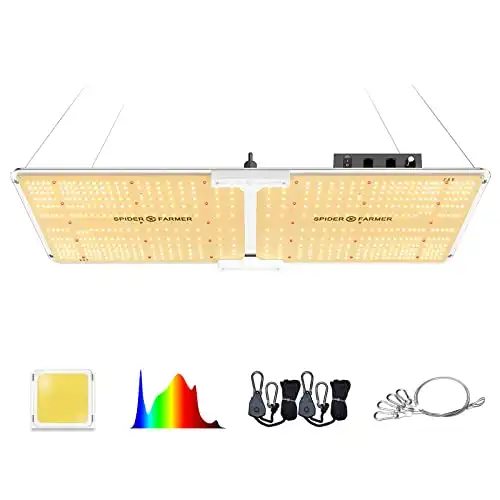
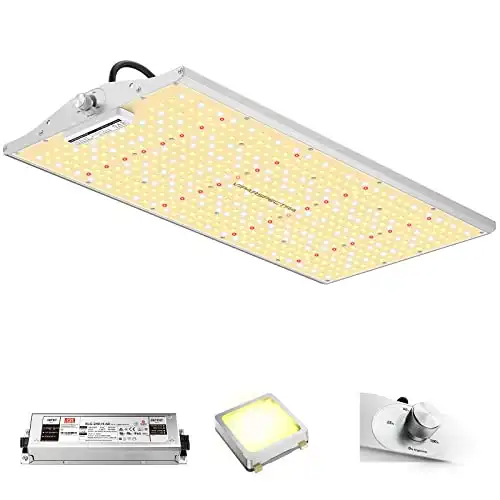
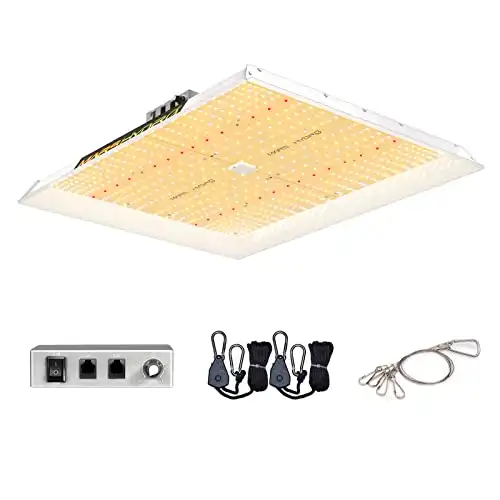
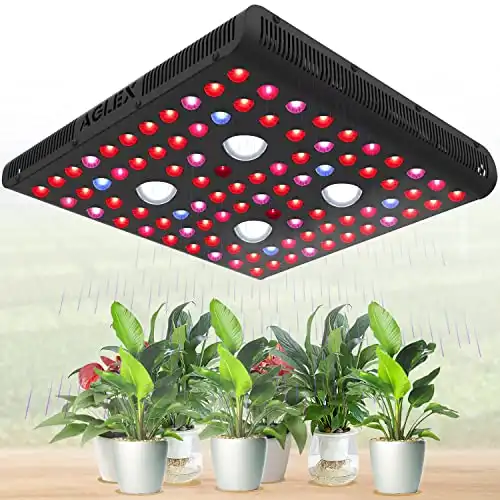
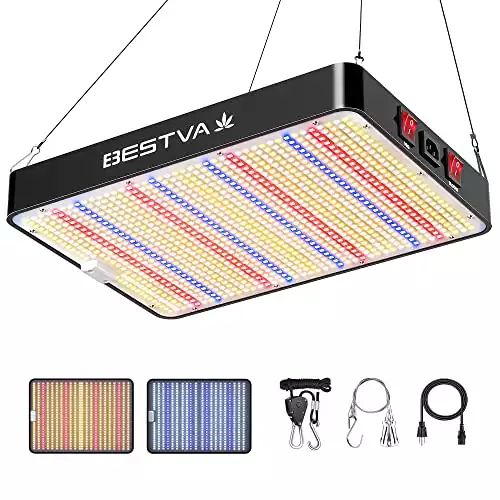
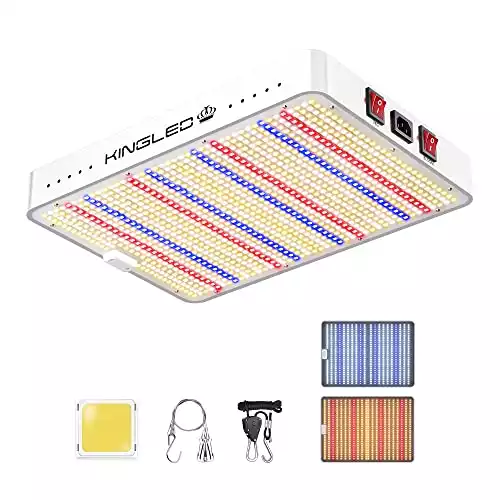
Owing to a variety of websites suggesting Bestva were the ideal lighting solution, I bought four units. They all failed within a matter of three months. I contacted the company regarding replacements which were sent out really quickly, but were 50% DOA. Having sent photos and emails regarding the failed units since then, there has been no response from the company.
From my experience, I would NO recommend Bestva for anything!
Unfortunately, this is the problem with all Chinese brands. There is a higher chance that you get a bad light and if you do get a bad one, it is harder to get help from the company.
If you want to avoid that risk, you have to buy from a non-Chinese company and pay over $1000. To some, the peace of mind is worth it. Others prefer to pay far less and take the risk. It’s a decision everyone has to make for themselves.
As far as Chinese brands go, BestVA is one of the best. As you said, you got replacements quickly. That would not have been the case with most other brands. Unfortunately, you got more bad lights…
One can tell that you are ill-informed about even the basics. 1.) Plants do NOT need green light, the reason they are green (aside from chlorophyll) is green is the only color not being absorbed. Thus it is reflecting the green outward. 2.) You compare Bestva’s 390w (actually 392w but who’s counting) as being equivalent to 700w HID, but because you are foregoing all the power that would be wasted on green lighting, and not considering the extra UV lighting provided by the LED, I believe that comparison sells the LED short. I appreciate you taking the time to experiment with these devices, but please educate yourself more regarding light spectrum before you go out serving Kool aid. Thanks
This is what the “blurple” manufacturers have been telling us for years, but there is a reason the industry is moving toward white light: plants do make use of green light. Just not as much. Even the “blurple” lights now all include white diodes. At least all of the top brands do.
hi id like to know i have the top one 2000 watt light so i should put it 18 inches from top of plant and ( i m new at this completely) i ahouls put blooom light fiirst and for 12 hours a day and turn if at night bit do thia for how long? how do i know when to switch to flower and keep it at 12 hour again and turn of at night keep temp between 20 and 28 ? the fan is on when light R on and humidifier on 8o? day time when lamp on i so
it in basement room that build for tent 4 by 4 feet. basically everything i told u that i know can u pls tell me my mistakes and how to do thins proper my [email protected] pls id be grateful id u helped me
18 hrs light for vegetative, 12 for flowering. Veg for about 40 to 50 days until plant shows sex, maturity creates better plants, then switch to 12 x 12 for flower cycle, about 2 months or a bit more. Do not mess with dark period during 12×12, no light, dont look at the because light will cause undesirable outcome. Check out rollitup. Good people, excellent knowledge. Hope this helps you out, goodluck and enjoy growing them. You will make mistakes but thats how we learn.
How far dit u hang the 2000w lights on flower and what was the best distance from conopy
Hi mate
I have a 90x90x180 room with 1 plant.
I have 1 greenfingers 1000 watt wich i belive is only equivalent to a 250hps.
Whould it be better to go the 1x 2000 watt bestva or just get another 1000watt.
Cheers
I generally prefer more smaller lights to one larger one (more flexibility, and if a light breaks, you still have another one), so I’d lean toward getting a second. However, I’m not familiar with greenfingers at all, so it’s hard to say in this case.